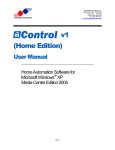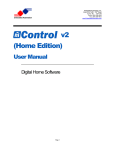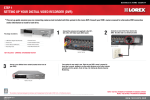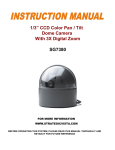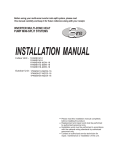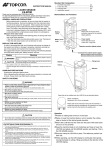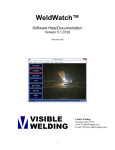Download Owner`s Manual
Transcript
DIGITAL VIDEO SECURITY SYSTEM START UP GUIDE Document Version 1.20.137 Application Version 1.20.137 05/03 NOTE: THIS MANUAL IS DESIGNED FOR SOFTWARE VERSION 1.20.137. YOU MAY BE ASKED UPON INSTALLATION TO DOWNLOAD A NEWER SOFTWARE VERSION WHICH WILL INCLUDE UPDATED FEATURES AND INFORMATION. FOR THE MOST UP TO DATE STARTER’S GUIDE, PLEASE PRINT THE START UP GUIDE FROM THE HELP MENU. Digital Video Security System is undergoing continuous improvement to the software. You may be prompted to update the DVS software upon installation. Note: This document is designed as a Starter’s Guide. For a more complete Digital Video Security System manual, please print it from the Help menu. Under the copyright laws, neither the documentation nor the software may be copied, photocopied, reproduced, translated, or reduced to any electronic medium or machine-readable form, in whole or part without the prior written consent of Strategic Vista Corp., except in the manner described in the documentation. © Copyright 2002 Strategic Vista Corp. 300 Alden Road Markham, Ontario L3R 4C1 CANADA All rights reserved. Printed in Canada. Sylvania is a registered trademark of OSRAM SYLVANIA INC. Used under license agreement. Other brand names and product names are the property of their respective owners. Table of Contents 1 Read Me First.............................................................................................................. 2 1.1 Steps to Get Going............................................................................................ 2 1.2 How to Use This Manual................................................................................... 2 1.2.1 1.2.2 2 3 User’s Manual Layout................................................................................... 2 Symbols Used in This Manual ..................................................................... 3 1.3 System Contents............................................................................................... 3 1.4 Minimum System Requirements...................................................................... 4 1.5 Windows Help File ............................................................................................ 5 1.6 Support .............................................................................................................. 5 1.7 FCC Compliance ............................................................................................... 6 Installing Digital Video Security System.................................................................. 7 2.1 Installing the Software Application ................................................................. 7 2.2 Installing the Video Drivers............................................................................ 14 2.3 Connecting the Hardware............................................................................... 17 2.4 Setting Up/ Installing Your Video security Camera ..................................... 20 2.5 To Uninstall...................................................................................................... 21 Tutorial ...................................................................................................................... 23 3.1 Launching the Application ............................................................................. 23 3.2 Quick Overview of the Interface .................................................................... 23 3.2.1 3.3 The Main Application Window: An overview ........................................... 23 Getting Started ................................................................................................ 24 ................................... 24 3.3.1 Setting up a Local Surveillance Connection 3.3.2 Opening the Local Video Surveillance Connection 3.3.3 Viewing Video Locally 3.3.4 3.3.5 Adding Alarms ..................................................................................... 28 Setting Actions in Response to an Alarm ................................................ 31 ........................ 27 ....................................................................... 28 3.3.6 3.3.7 3.3.8 3.3.9 3.3.10 Adding Scheduled Events ................................................................. 39 Enabling Local Surveillance to be Viewed Remotely.............................. 47 Setting up a Remote Surveillance Connection ........................................ 47 Viewing Live Video Remotely .................................................................... 50 Video Playback .............................................................................. 51 4 Camera Specifications............................................................................................. 54 5 Glossary .................................................................................................................... 55 6 Support ..................................................................................................................... 56 Chapter 1: Read Me First 1 Read Me First Digital Video Security System enables you to monitor and protect your business, home or office from across the hall or around the world. The video grabber software provided with Digital Video Security System, allows you to set up a PC based security system in minutes that can: Stream Live Full-Motion Video – Watch what is going on in the next room, or around the world via the internet or dial up option Detect Motion – When the alarm feature is activated, the system will automatically dial a telephone or pager number that you have selected and play an emergency message. You can also have the system send an email. Record Digital Video – Manage digital recording sessions or save the video as a streaming file that can be replayed.. Review the video using still frame, forward, fast forward and other video management capabilities. Control Home Automation – Use any X10 Home Automation and Wireless devices to control lighting and other features available with X10-compatible systems Schedule Events – Schedule video recording, e-mail notification, X10 Home Automation and more based on a user-defined schedule 1.1 Steps to Get Going Listed below are the recommended steps for installing Digital Video Security System: Check your package using the list on the next few pages to make sure you received the complete system. Confirm that your computer meets the system requirements for Digital Video Security System. Install Digital Video Security System 1.2 How to Use This Manual This user’s manual describes the contents of Digital Video Security System and system requirements. It also provides installation instructions and tells you where to go for more information. 1.2.1 User’s Manual Layout This manual is designed to get you started quickly, while providing you with a full reference. Each chapter is self-contained so that the manual does not have to be read in sequence. The manual is divided into the following chapters: Chapter 2 Title Description Installation Describes installation and setup of hardware and software Digital Video Security System Start Up Guide 2 Chapter 1: Read Me First 3 Tutorial Overview of the main software features 4 Specifications Describes specifications for computer and camera 5 Glossary Definitions of common terms used in this manual Support Outlines available support to Digital Video Security system users 6 Screen shots in this manual have been taken on a system running Windows 2000. There will be small differences to the external appearance of the application windows and dialogs running on Windows XP, 98 or ME. The layout of the windows and dialogs and their content are identical for all Windows systems supported. 1.2.2 Symbols Used in This Manual Throughout this manual a set of comments are employed to provide emphasis to certain points. A left-hand icon indicates the type of comment as follows: This type of comment represents a feature or aspect of the Digital Video Security System that is particularly beneficial to the user. Text in this note is italicized and bold. This type of comment represents information that you will find useful, such as a shortcut or a “how-to” to avoid common mistakes. Text in this note is bold. THIS TYPE OF COMMENT REPRESENTS SOMETHING TO BE AWARE OF OR BE CAUTIOUS ABOUT. TEXT IS BOLD AND UPPERCASE. 1.3 System Contents y y Video Grabber with USB cable – A PC interface that allows you to connect a video device, such as a security camera, to your PC. Software – There are 2 discs included in the Digital Video Security System: The Software Application and the Video Drivers. The Software Application software enables you to monitor and protect your business, home or office from across the hall or around the world. The Video Drivers enable the hardware to be compatible with your PC. Digital Video Security System Start Up Guide 3 Chapter 1: Read Me First Color Video Security Camera (included with VG1100 system) – A highquality color video security camera with cable and 12 V DC power supply. Note: if you purchased VG1000, you will need to purchase a video security camera. User’s Manual – Full reference to the features of Digital Video Security System. y y Video Grabber with USB Cable Application Software and Video Driver CD Owners Manual Color Video Camera with 56ft extension cable & camera bracket - Included with Model VG1100 DO NOT PLUG THE VIDEO GRABBER INTO THE USB PORT OF YOUR COMPUTER. YOU MUST FIRST RUN THE INSTALLATION SOFTWARE. 1.4 Minimum System Requirements The minimum system requirements for the Digital Video Security System are: Processor Pentium II or higher RAM 32 MB Ram Windows O/S Windows 98, Windows ME, Windows 2000 , Windows XP Video Card Any VGA Compatible Video Card Display 800 x 600 VGA Digital Video Security System Start Up Guide 4 Chapter 1: Read Me First Sound Card Built into Color Camera with VG1100; Built in sound Card to most computers Disk Space 40 MB available hard disk space Modem 28 bps or higher modem CD-ROM Drive Required for software installation Computer Connection USB Camera Included with VG1100 (not included with VG1000) 1.5 Windows Help File The Digital Video Security System User’s Manual is available in modified form as a Windows Help file. To access the online Help file, select Help from the Digital Video Security System application itself. 1.6 Support The following 3 options are available for technical support: Type Contact Hours On-line Support Please visit our website at www.strategicvista.com for free technical information anytime and weekly updates to the most frequently asked questions 24 Hours / 7 days a week Email Support Please email your queries to us at [email protected] If you are experiencing a technical problem, you can also send the configuration file to us for assistance Allow 24 Hours (Mon-Fri) for a technical support person to respond to your query Telephone Support Should you need to talk with a customer support representative please visit our website at www.strategicvista.com for the most up to date telephone customer support phone number. Note that a fee may apply for this service. Support available 7 Days a week Digital Video Security System Start Up Guide 5 Chapter 1: Read Me First 1.7 FCC Compliance This equipment has been tested and found to comply with the limits for a class B digital device, pursuit to Part 15 of the FCC rules. These limits are designed to provide reasonable protection against harmful interference in a residential installation. This equipment generates, uses and can radiate radio frequency energy and, if not installed and used in accordance with the instructions, may cause harmful interference to radio communication. However there is no guarantee that interference will not occur in a particular installation. If this equipment does cause harmful interference to radio or television reception, which can be determined by turning the equipment off and on, the user is encouraged to try to correct the interference by one or more of the following measures: Reorient or relocate the receiving antenna increases the separation between the equipment and receiver Connect the equipment into an outlet on a circuit different from that to switch the receiver is connected Consult the dealer or an experience radio or television technician for help. This device complies with Part 15 of the FCC rules. Operation is subject to the following two conditions: 1. This device may not cause harmful interference, and 2. This device must accept any interference received, including interference that may cause undesired operation This digital apparatus does not exceed the Class B limits for radio noise emissions from digital apparatus set out in the Radio Interference Regulations of the Canadian Department of Communications. ALWAYS USE DISCRETION WHEN INSTALLING VIDEO AND AUDIO SURVEILLANCE EQUIPMENT ESPECIALLY WHEN THERE IS PRECEIVED PRIVACY. INUQIRE REGARDING FEDERAL, STATE AND OR LOCAL REGULATIONS APPLICABLE TO THE LAWFUL INSTALLATION OF VIDEO AND OR AUDIO RECORDING OR SURVEILLANCE. PARTY CONSENT MAY BE REQUIRED Digital Video Security System Start Up Guide 6 2 Installing Digital Video Security System This chapter describes how to install Digital Video Security System. You will need a video security camera (included with VG1100) to operate this system. Screen shots in this manual have been taken on a system running Windows 2000. There will be small differences to the external appearance of the application windows and dialogs running on Windows XP, 98 or ME. The layout of the windows and dialogs and their content are identical for all Windows systems supported. NOTE: FOR WINDOWS 98 AND ME USERS, YOU MAY BE PROMPTED FOR YOUR WINDOWS 98 OR WINDOWS ME OPERATING SYSTEM CD. PLEASE HAVE THIS CD HANDY DURING THE DIGITIAL VIDEO SECURITY SYSTEM INSTALLATION DO NOT PLUG THE VIDEO GRABBER INTO THE USB PORT OF YOUR COMPUTER. YOU MUST FIRST RUN THE INSTALLATION SOFTWARE. 2.1 Installing the Software Application To install the Digital Video Security System software application, simply insert the Software Application CD (not the Video Drivers CD) into your computer’s CD-ROM. After a few seconds the Setup application will automatically run. On some systems the Windows auto-start is turned off. If the Setup application does not run within a few seconds after you place the installation CD in the CD-ROM drive, go to the Start - Run option. Select browse to find the CD-ROM drive and double-clicking the Setup.exe file. When the Setup starts up you will see the Windows Installer main window: Digital Video Security System Start Up Guide 7 Follow the instructions of the standard Windows installation dialog, which will guide you through the installation process. YOU MUST ACCEPT THE LICENSE AGREEMENT PANEL OR THE INSTALLATION WILL NOT CONTINUE. The next two panels will require you to accept the license agreement, and enter your customer information. You will then be prompted with the following Setup Type panel: Digital Video Security System Start Up Guide 8 Select the Complete Setup option and click on Next. The installation may appear to pause during the installation process. If this happens let the installation software proceed. It is automatically configuring your Windows environment to determine what it needs to install in order for the Digital Video Security System software application to operate properly. The following window will update you as to the progress of the installation: Digital Video Security System Start Up Guide 9 The installation automatically installs Windows Media Player 9 Series if it is not already on your system. The Digital Video Security System is based on a Widows Media platform, and WM9 offers improved streaming audio/video performance from previous versions of the software. Digital Video Security System Start Up Guide 10 Once Windows Media 9 is installed, you will be prompted with a setup dialog for DirectX. DirectX is the core Windows® technology that drives high-speed multimedia and games on the PC. For more information on the features of DirectX, please refer to the following link: http://www.microsoft.com/windows/directx/default.aspx An advantage of having a Windows Media platform is that Windows Media software is constantly being improved. As Windows Media improves, the audio and video streaming quality of the Digital Video Security System improves as well! Follow the instructions of the standard DirectX 9.0 installation dialog, which will guide you through the installation process. Digital Video Security System Start Up Guide 11 After DirectX 9.0 is installed, the installing process for the Digital Video Security System application software will resume. When the installation is completed you will see the following window. Once the installation of the Digital Video Security System application is complete, you must Restart your system in order for the new settings to take effect. Digital Video Security System Start Up Guide 12 Note: On some Windows XP computers you may see the window shown below during the installation process: Simply press Continue to proceed. On Windows 2000 a variation of this window appears during installation, shown in the picture below. Simply press Next to continue. Digital Video Security System Start Up Guide 13 2.2 Installing the Video Drivers Now that you have installed the software application and restarted your computer, insert the Video Drivers disk into your CD-ROM drive. In Windows, go to your Compact Disc drive in which the software is situated. You will notice a number of files on the CD, as shown in the following picture: Digital Video Security System Start Up Guide 14 Double click on the Setup application icon, and the Video Capture driver installation will commence. Digital Video Security System Start Up Guide 15 Follow the instructions to install the video drivers. You will see the screen shown below when the driver installation is complete. Digital Video Security System Start Up Guide 16 SINCE DRIVERS ARE INSTALLED IT IS RECOMMENDED TO RESTART YOUR SYSTEM EVEN IF THE INSTALLATION DOES NOT REQUIRE IT PRIOR TO PLUGGING IN YOUR VIDEO CAMERA. 2.3 Connecting the Hardware Once the installation of the Software Application and Video Drivers is completed, connect the Video Grabber to the USB port on your computer using the supplied cable. The Video Grabber is designed as a Plug-and-Play device. The Windows device manager will automatically finds and recognizes the Video Grabber with the Found New Hardware Wizard. The following image depicts the Video driver being automatically detected and installed by the Found New Hardware Wizard. Digital Video Security System Start Up Guide 17 Both Video and Audio drivers are installed. The next image shows the installation of the Audio driver being completed. Digital Video Security System Start Up Guide 18 DEPENDING ON YOUR SYSTEM, THE VIDEO AND AUDIO DRIVERS MAY NOT BOTH BE DETECTED AND INSTALLED IMMEDIATELY AFTER PLUG-IN OF THE HARDWARE. IF ONE OF THE TWO DRIVERS ISN’T BEING DETECTED, TRY UNPLUGGING AND REPLUGGING THE USB DEVICE, OR RESTART YOUR PC. On some Windows XP computers you may see the following window during the video driver installation: Digital Video Security System Start Up Guide 19 Simply press Continue to proceed. On Windows 2000 a variation of this window appears when you install the Video Grabber into the USB port. Simply press Continue as well. Depending on what the Setup application needed to install, you may be prompted to restart Windows in order to complete the installation. SINCE DRIVERS ARE INSTALLED IT IS RECOMMENDED TO RESTART YOUR SYSTEM EVEN IF THE INSTALLATION DOES NOT REQUIRE IT PRIOR TO PLUGGING IN YOUR VIDEO CAMERA. You can now plug any video security camera into the Video Grabber (included with VG1100) and start monitoring your business, home or office. 2.4 Setting Up/ Installing Your Video security Camera For users who purchased model VG1000, refer to your Video Security Cameras owners’ manual for installation of your security camera. Once the security camera has been set up, simply connect the RCA cable from the camera to Video Grabber. For users who purchased model VG1100, proceed with the following steps: Digital Video Security System Start Up Guide 20 1. Attach the camera bracket to the camera. Position the security camera in the desired viewing location. Note: A color camera requires a certain level of light. You may need to adjust the camera position and/or the amount of light in the room for optimum viewing. 2. Run the supplied 17-meter (57ft) cable from the camera to video grabber. Connect the audio and video RCA leads to Video Grabber and plug the camera into an electrical outlet using the supplied 12 V DC power supply. Refer to Technical Specifications at the back of this manual for detailed information on the camera. If this was your first time setting up a security system, congratulations! You just set up a sophisticated digital video monitoring system in minutes! Continue to the next chapter and you will be watching video in another couple of minutes. 2.5 To Uninstall To uninstall Digital Video Security System go to the Add/Remove Programs option in the Control Panel of Windows. First click on the DVS System item to uninstall the main Digital Video Security System application. The Digital Video Security System Uninstall program will prompt you with the following window: Select Remove and follow the on-screen instructions to remove the Digital Video Security System application. Digital Video Security System Start Up Guide 21 After the Digital Video Security System is uninstalled you must separately uninstall the video camera drivers by selecting the Video Capture item in the Add/Remove Programs list. You will be prompted with the following window: Simply click OK and continue with the on-line instructions. YOU MUST REMOVE THE VIDEO CAPTURE DRIVERS SEPARATELY AS DESCRIBED ABOVE BEFORE REINSTALLING THE DIGITAL VIDEO SECURITY SYSTEM OR YOU MAY RUN INTO CONFLICTING DRIVER ISSUES. Digital Video Security System Start Up Guide 22 3 Tutorial This tutorial will introduce you to the basic concepts of the Digital Video Security System application, with the goal of getting you up and running quickly in 30-45 minutes. It will provide you with an understanding of how to navigate through the Digital Video Security System software to set up a basic security system with a minimum of effort. A more complete description of all of the powerful features of the Digital Video Security System application is contained in the Reference section of the Help menu. This tutorial uses a case study approach that assumes you are the owner of a thriving store. You have hired a new employee to manage the store in your absence. You are working out of your home office and would like to do the following: Monitor how the cash register is closed down for the day; Check on your store at random during the day from your home office; Ensure that there are no intruders after business hours. You can use the Digital Video Security System software for all these capabilities, and more. Let’s get started! 3.1 Launching the Application To launch the Digital Video Security System application, select it from the Programs | DVS menu option, or click on the DVS icon. Upon entering the program, you will immediately see live video from the camera! Please close this window for now in order to follow the Tutorial and gain a better understanding of the software. 3.2 Quick Overview of the Interface Digital Video Security System is comprised of a main application window from which you launch and control the specific features of the application 3.2.1 The Main Application Window: An overview The main window contains four areas and appears as follows: Digital Video Security System Start Up Guide 23 Menu Bar Tool Bar Connections Window Main Window Feedback Window Status Bar The menu and tool bars provide you with access to the feature set of the Digital Video Security System application. The main window is where all launched windows will open, and the status bar provides you with feedback on any operation Digital Video Security System is carrying out. By default, a Connections window and a Feedback window will be opened in the main Digital Video Security System window. A camera connection called Main Camera has already been set up for you. 3.3 Getting Started Using the case study scenario described in the introduction to the tutorial, your store will be set up as the local surveillance connection. The local surveillance is always the location of the video camera. Later in this tutorial you will set up your home office as the remote surveillance connection. The remote surveillance is the location from which you will remotely monitor and control the security at the store. 3.3.1 Setting up a Local Surveillance Connection You will use this window to set up the local connection to the video camera in your store. Digital Video Security System Start Up Guide 24 A preset default Connection has already been created for you. Please refer to the next two sections for instructions on Opening Connections and Viewing Video Locally. However, before proceeding, it is important to practice setting up your own connection. A local connection is set up at the computer that has the Video Grabber, camera and Digital Video Security System software installed. It is referred to as Local Video because the security camera is connected directly to this computer. The Digital Video Security System will stream video from this location to the internet, thus it is sometimes also referred to as the host computer. Note that the Connections Window has its own toolbar. All windows have their own toolbar for added convenience and ease-of-use. New Connection icon. You will be To set up your own connection, select the presented with the following Add Connection dialog box: Digital Video Security System Start Up Guide 25 Type a descriptive name in the label field; in this example “Store Surveillance Camera”. The Connection Information area will have the connection method, video device and audio device pre-selected as the default setting. For this tutorial leave the Login information fields blank. Select OK, and the new connection is added. It is that simple! You will see your new connection listed in the Connections window, as shown below: Login information is an optional setting, however very important. Login information protects the camera from unauthorized use as only those people who know this information are able to access the camera. (refer to Setting Up a New Local Connection in the Reference section of the Help menu for more details) Digital Video Security System Start Up Guide 26 All connections are automatically saved when you exit the application. You do not have to specifically save your connections. 3.3.2 Opening the Local Video Surveillance Connection Now that the connection has been set up, you will open the connection window in order to: Monitor the video camera locally Enable remote locations to monitor the local camera Optionally establish alarms and set up the corresponding trigger actions Optionally set up scheduled events Digital Video Security System allows you to schedule events or alarms. A scheduled event is when you pre set a specified date and time. For example if you want to record a picture every day at 9:00am, you would schedule this event. An alarm is a set when motion is detected at the camera. For example, if someone were to come into the warehouse at nighttime, digital video security system will trigger the computer to begin recording to your computer’s hard drive. To open the connection you have just set up, select the Store Surveillance Camera connection by either double-clicking on its label, or by highlighting the label with your Open Connection icon from the Connection window. The mouse and selecting the following Local Video Surveillance window will open: Digital Video Security System Start Up Guide 27 The Local Video Surveillance maintains the connection label in the title bar to identify which connection it is controlling. This is the descriptive label that you entered when creating the connection. 3.3.3 Viewing Video Locally Upon opening the connection, live video will appear (allow approximately 10 seconds for the camera picture to appear). This lets you preview what will be transmitted remotely, and enables you to adjust your camera appropriately for both local and remote viewing. To stop the video camera from displaying in the window, simply press the on the toolbar. After video is stopped, you can press the video. 3.3.4 Stop button Play icon to resume viewing Adding Alarms In this next section, we will cover how to set up an alarm that will detect security breaches based on motion detection. Once again, an alarm is set when motion is detected at the camera. For example, if someone were to come into the warehouse at nighttime, digital video security system will trigger the computer to begin recording to your computer’s hard drive. An alarm can trigger the following events: Digital Video Security System Start Up Guide 28 Notify you via e-mail; Automatically dial a phone or pager; Capture the motion on video; Turn ON or OFF lights or other electrical devices using X-10 controllers New Alarm icon in the In order to set up an alarm for Motion Detection, click on the Local Video Surveillance window. The Motion Detection Alarm dialog will open, as shown in the following screen: DVS already has Record Video as the first default action item. This means that if motion is detected, DVS will automatically record the picture for the 20 second duration and save the file on your computer’s hard drive. DIGITAL VIDEO RECORDING MAY USE UP DISK SPACE AND SHOULD THEREFORE BE USED CAUTIOUSLY. EACH MINUTE OF VIDEO RECORDING IS APPROXIMATELY 1.5 MB. Type in a descriptive label for the alarm; in this example, “Weeknights”. Digital Video Security System Start Up Guide 29 You can set up multiple alarms. Each one is identified by a unique label that you select. Refer to the reference section for more details. Fill in the Begin and End times that the Motion Detection Alarm should be active. For example, in this case we will select the nighttime hours when the store is closed. To change the times, position your mouse in the hours, minutes or AM/PM field, and use the up or down arrows to scroll to your desired settings. Alternatively, you can highlight any of the fields and type the desired information in manually, one field at a time. In the Scheduled Days region, select the check the days from Monday through Friday. button. This will automatically If you accidentally pressed OK and closed out of this dialog, your information is still saved. Click on the Alarm label in the Local Video Surveillance window to re-open the Motion Detection Alarm dialog. The Motion Detection Alarm dialog will now appear as follows: Digital Video Security System Start Up Guide 30 In the next section, you will add the Actions that should occur upon detection of motion such as sending an e-mail, dialing a phone or pager, playing an audio file or activating an X-10 device. 3.3.5 Setting Actions in Response to an Alarm You can set up as many actions as you want as a result of motion being detected, including multiple occurrences of the same type of action. This section of the tutorial reviews setting up one of each possible action. Digital Monitoring System executes alarm actions simultaneously. This means for example, that DVS will record video, send email and call a phone at the same time. Within one action, however, the action is sequential. For example, if you have Digital Video Security System set to call four different telephone numbers, DVS will dial the phone numbers in the sequence that it was entered. Fore more details on setting Motion Detection, refer to Motion Detection in the Reference section of the Help menu. Digital Video Security System Start Up Guide 31 3.3.5.1 Send an E-Mail To add an action that sends e-mail as a result of motion detection, select Send e-mail from the Add Action drop-down box in the Motion Detection Alarm window and click Add. You will see the following dialog: In order for email to operate, you will need to be connected to your internet provider. As with most e-mail systems, enter the address and fill in the subject and message fields. Before selecting OK, you can first test the e-mail by selecting the Test option. This will immediately send the e-mail to the selected address, so you can ensure it will be sent to the correct recipient in the case of an alarm. All of the Action dialogs give you the option of testing your settings. Testing your settings confirms that your e-mail (or any other email action) ends up where you expected. As a safety feature built within Microsoft Outlook, user intervention is required to send email. Digital Video Security system therefore cannot automatically send email when an alarm has taken place. It is therefore recommended that you use Outlook Express or Netscape when using Digital Video Security System. Digital Video Security System Start Up Guide 32 Select OK. With these simple few steps, you have established that if motion is detected between the hours of 9:00 PM and 8:00 AM on weekdays, a 20 second video will record to your computer’s hard-drive, and a pre-specified text e-mail alert will be sent. The Motion Detection Alarm window will appear as follows: In the window that lists the actions, the Details column provides a brief summary of the action so that you can easily identify it. 3.3.5.2 Dial a Telephone or Pager To add an action that places an automated call to a telephone or pager as a result of motion detection, select the Dial Phone or Pager option from the drop down Action Menu and click ADD. You will see the following dialog: Digital Video Security System Start Up Guide 33 Enter the phone number of the emergency contact and the dial (DTMF) tones you will be sending to the pager. (For full details on the various aspects of this Action, please refer to “Action: Dial a Telephone or Pager” in the Reference section of the Help menu). You can optionally place dashes (‘-‘) to present the phone numbers in familiar form (999-9999), though this will not affect how the number is dialed out. Wait to connect is the amount of delay time you want prior to the dial tone or audio file to be sent. For example, if the wait to connect was sent to 10 seconds, Digital Video Security System will wait 10 seconds after dialing the phone number to start playing a specified audio message. A DTMF Tone is simply the sound you hear when you press the buttons of a standard phone. DTMF Tones correspond to the numbers on the phone keypad (i.e., 0 through 9). To ensure that the call goes where you intended, use the Test feature. This will place an immediate call according to the information you have entered. Sending a test phone or pager message does not affect any operation when motion is detected. It is merely a convenience to ensure that you entered information correctly into the dialog. If your system does not have a tapi compliant modem, the telephone action will not dial out. Press OK. Now you have established that, in the event of motion detection during the hours of 9:00 PM and 8:00 AM during the week, three actions will take place: a 20 second video will record to your computer’s hard-drive, a pre-specified e-mail will be sent and; third an automated telephone call will be placed to a pager. The Motion Detection Alarm window will appear as follows: Digital Video Security System Start Up Guide 34 Note that two Actions to the same alarm are now listed in the Actions region of the Motion Detection Alarm window. 3.3.5.3 Play Audio File The audio alarm allows you to be alerted by an audio sound when motion is detected at the camera’s location. The audio sound will alert you to look at your computer to see what is happening at the computer. From the Motion Detection Alarm dialog, choose Play Audio File from the Add Action drop-down list and click Add. The following dialog will appear: Digital Video Security System Start Up Guide 35 Select an audio file from the dialog box by pressing the button. Press the Play button to hear the audio file that you selected. Alternatively, you can also Record your own audio message as a .wav file that can serve as your audio alarm. Press OK. You have now established that, in the event of motion detection during the hours of 9:00 PM and 8:00 AM during the week, four actions will take place: A 20 second video will record to your computer’s hard-drive A pre-specified e-mail will be sent; An automated call will be placed to a pager; An audio file will play to alert you of motion at the camera The Motion Detection Alarm window will appear as follows: Digital Video Security System Start Up Guide 36 Note that four Actions to the same alarm are now listed in the Actions window of the Motion Detection Alarm window. 3.3.5.4 Activate X-10 To add an action that controls X-10 devices such as lights and other electrical outlets as a result of motion detection, select Control X-10 devices from the Add Action drop-down box in the Motion Detection Alarm window and press Add. You will see the following dialog: Strategic Vista, the manufacturer of Digital Video Security System is not affiliated in any way with X-10. You will need to contact X-10 directly to purchase the “Firecracker” and other X-10 devices. In order to use the X-10 capabilities, you need to purchase a CM17a X10 controller, otherwise known by its nickname “FireCracker”. The FireCracker device is a small connector that plugs into the Serial port of your computer and transmits an RF signal to an X-10 receiver that is plugged into the wall. Consult with X-10 to see what other feature / options can be made available through X-10 for use with Digital Video Security System. Enter the House and Device Codes that, in combination, might identify the lights in the front of the store. You may either input the code values using your keyboard, or select the desired value from the drop down boxes to the right of each field. (For details about valid input values for these fields, refer to “Action: Control X-10 Devices” in the Reference section of the Help menu; for a brief overview of the X-10 protocol, please see the X-10 Reference section of the Help menu). Set the Command to ON, indicating that the lights should turn on when motion is detected. Running Test will turn on the selected lights immediately, confirming that you have accurately entered the Codes you desired. Digital Video Security System Start Up Guide 37 Press OK. You have now established that, in the event of motion detection during the hours of 9:00 PM and 8:00 AM during the week, five actions will take place: A 20 second video file will record to your computer’s hard-drive A pre-specified e-mail will be sent; An automated call will be placed to a pager; An audio file will play to alert you of motion at the camera Lights in the front of the store will turn on. The Motion Detection Alarm dialog will appear as follows: Note that five Actions to the same alarm are now listed in the Actions region of the Motion Detection Alarm window. Digital Video Security System Start Up Guide 38 You may close the Motion Detection Alarm dialog by pressing OK. Your Local Video Surveillance window will now reflect the Alarm you have just added: You can edit the Alarm you just created by double-clicking on the Weeknights alarm icon. 3.3.6 Adding Scheduled Events Let us now focus on the events that you may choose to schedule on a regular basis. A Scheduled Event is a set of actions that are designated to occur on a weekly basis at predesignated times. One example might be to have all the lights automatically turn off at night, or recording the closing out of the cash register every evening. Adding a Scheduled Event is as easy as adding an alarm and can include: Sending an e-mail Automatically dialing a phone or pager Recording video Controlling X-10 devices Playing an audio file The Scheduled Event dialog enables you to flexibly select events that can be scheduled in any combination of days or times of the day, such as weeknights, weekdays, weekends, etc. Digital Video Security System Start Up Guide 39 To demonstrate the simplicity of adding a Scheduled Event, which is nearly identical to adding an Alarm, let us walk through the two examples mentioned above, which are setting the lighting at a pre-designated time and recording the cash register every evening. 3.3.6.1 Open Scheduled Event Dialog From the Local Video Surveillance window, which should still be open, click on the Add Scheduled Event. The following dialog will appear: Notice that the Schedule Event and Motion Detection Alarm windows are almost identical. You can apply all that you learned in the last section to quickly go through setting up actions based on a scheduled event. With the exception of the Scheduled Time field, this dialog is identical to the Motion Detection Alarm dialog. (In setting up an Alarm, you choose both a start and end time; for a Scheduled Event you need to select only a start time.) Digital Video Security System Start Up Guide 40 Type in a descriptive label; ours reads “Turn Off Lights.” Enter 10:00 PM in the Scheduled Time field by positioning your mouse in the hours, minutes or AM/PM field, and using the up or down arrows to scroll to the correct time. Alternatively, you can highlight any of the time fields and manually type in the desired information, one field at a time. In the Scheduled Days region, select the check all seven days. button. This will automatically The Scheduled Event window will appear as follows: 3.3.6.2 Activate X-10 You can now specify which action you would like to schedule; namely, accessing the X-10 protocol to turn off all lights. Digital Video Security System Start Up Guide 41 Setting up any of the Actions in a Scheduled Event – e-mail, dial a phone or pager, record video or activate X-10 – is identical to setting up an Action in response to an Alarm. From the Add Actions drop-down list, select Control X-10 devices and press Add. The following dialog will open: Enter the House and Device Codes that, in combination, identify all of the lights in the store. You may either input the code values using your keyboard, or select the desired value from the drop down boxes to the right of each field. (For details about valid input values for these fields, refer to “Action: Control X-10 Devices” in the Reference section of the Help menu; for a brief overview of the X-10 protocol, please see the X-10 Reference section of the Help menu). Set the Command to OFF, indicating that all lights should be shut off. Running Test will turn off the selected lights immediately, confirming that you have accurately entered the Codes you desired. Press OK. The Scheduled Event window will appear as follows: Digital Video Security System Start Up Guide 42 You have now established that every night, at 10:00 PM, all of the lights in the store will be turned off. Press OK on the Scheduled Event Window to save these settings. As shown below, the Local Video Surveillance window will reflect that both an Alarm and a Scheduled Event have been established: Digital Video Security System Start Up Guide 43 3.3.6.3 Record Video From the Local Video Surveillance window shown above, select the Schedule Event icon. When the Schedule Event window opens, enter the following information: Event Label: Cash Register Closing Scheduled Time: 9:00 PM Scheduled Days: Check all days but Sunday Your Schedule Event window should look like this: Digital Video Security System Start Up Guide 44 From the Add Action drop-down list, select Record video and press Add. When the Video Record Action dialog opens, input the following information: Duration: 20 seconds Continuous Record: unchecked The Video Record Action Dialog will look like this: Running Test will immediately capture the pre-specified 20 seconds of video, and will store the video capture in the default video record file. Digital Video Security System Start Up Guide 45 Press OK. You have now established that six nights a week, at 9:00 PM, Digital Video Security System will record a 20 second segment of video and store it for future reference. The Schedule Event window will appear as follows: Select OK to close the Schedule Event window. Your Local Video Surveillance window will now reflect that you have established one Alarm and two Scheduled Events for the Store Surveillance Camera: Digital Video Security System Start Up Guide 46 3.3.7 Enabling Local Surveillance to be Viewed Remotely Once your local camera is set up properly in the store, you can enable it to be viewed remotely by others. When you open the Local Video Surveillance you can control whether a Connect and remote workstation can view the local video camera using the Disconnect icons found on the Local Video Surveillance toolbar. Once the Local Video Surveillance is connected, it is ready for a remote workstation to view the local video camera, as described in the next section. 3.3.8 Setting up a Remote Surveillance Connection In order for you to set up a remote location you must have the DVS software loaded on both computers and connected with your internet provider. The local/host computer must be kept on and the application must be open. Once your local camera is properly set up in the store, you can move to your home office, where you will set up a Remote Video Surveillance connection. Using this remote connection, you will be able to: Remotely monitor the live video feed from the store’s security camera; Remotely establish new Alarms or Scheduled Events for the store; Remotely modify existing Alarms and Events. Digital Video Security System Start Up Guide 47 There are two methods for establishing a remote connection to the host (local) computer: Fixed IP Address and Yellow Pages Entry. This tutorial demonstrates how to remotely connect to a host computer that has a Fixed IP Address. For details on remotely connecting to a host computer using the Yellow Pages Entry, please refer to the Yellow Pages Directory in the Reference section of the Help menu. Install the Software Application CD at your home office location following the directions in Section 2.1. Launch the application, as per instructions in Section 3.1. You do not need to install the Video Drivers CD on the remote PC. Upon entering the software from a remote location, you will find a dialog stating that No Video Device is detected. This message appears because the same software CD is used for both Local and for Remote applications. Simply click OK, ignore the message, and proceed to establish a Remote Surveillance Connection. From the main window of the Digital Video Security System application, click on the Connections icon, or select View | Connections, as you did in Section 3.3.1. Once the Connections window has opened, select the the Add Connection dialog box as follows: New Connection icon. Fill in the fields of Type in a descriptive label for this remote connection: “Home Office”. The Type of Connection will be pre-selected as Video Surveillance. Use the Connection Method drop-down list to select Fixed IP Address. Your Add Connection dialog will now appear as follows: Digital Video Security System Start Up Guide 48 Please note that the Connection dialog now has a new field requesting the Fixed IP Address. Enter the IP address of the computer at the store where you have the camera connected. (For more details on Connection Methods for Remote Connections, please refer to Remote Connections in the Reference section of the Help menu). If you need assistance to locate your computers IP address go to the menu bar and select help. From the drop down menu, select About Digital Video Security System. Your IP address will be shown. Press OK. That’s it! Your Remote Surveillance Connection has been set up! As shown in the following screenshot, the Connections window displays all of your established connections. Digital Video Security System Start Up Guide 49 Icons on the left represent whether the connection is local or remote, as follows: Connection Icons Description Denotes a LOCAL connection (i.e., the camera is connected to the PC at this location) Denotes a REMOTE connection (i.e., will connect you to a video camera at a remote location) 3.3.9 Viewing Live Video Remotely From the Connections window (as shown in the previous section), select which remote video connection you would like to access by double-clicking on its label with your mouse, Open Connection icon. You will be or highlighting the label and selecting the presented with the Remote Video Surveillance window, as shown: Digital Video Security System Start Up Guide 50 To remotely view the security camera footage live, press the Connect Icon. The video will play in the right side of the Remote Surveillance Window (first allow for 100% Buffering, and then wait about 10-15 seconds for the streaming video to appear) Digital Video Security System provides you live streaming video. There is therefore a latency period of about 15 seconds. Disconnect icon. To stop viewing the video from the remote location, simply press the You can connect and disconnect to the remote video as often as necessary. For further details about remotely viewing live video, please refer to “Remote Surveillance Window” in the Reference section of the Help menu. 3.3.10 Video Playback To replay previously captured video, use Digital Video Security System’s convenient Video Playback feature. From the main window, select the following window will open: Digital Video Security System Start Up Guide Video Playback icon. The 51 On the left-hand side of the window, you will see a listing of all video files stored in your default directory. (For more details on Configuring your default video directory, refer to Configuration in the Reference section of the Help menu) To view the video capture, double-click on the video of your choice. Video is played in the right-hand panel of the Video Playback window, using the embedded Window Media Player. When the video listing is in Detail mode, it automatically lists the date, start and stop times, and Local Video Surveillance camera that recorded the video. For more details on Video Playback and navigating the Windows Media Player, please refer to Video Playback in the Reference section of the Help menu. Digital Video Security System Start Up Guide 52 Specifications The following is the minimum system requirements for Digital Video Security System: Processor Pentium II or higher RAM 32 MB Ram Windows O/S Windows 98, Windows ME, Windows 2000 , Windows XP Video Card Any VGA Compatible Video Card Display 800 x 600 VGA Sound Card Built into Color Camera with VG1100; Built in sound Card to most computers Disk Space 40 MB available hard disk space Modem 28 bps or higher modem CD-ROM Drive Required for software installation Computer Connection USB Camera Included with VG1100 (not included with VG1000) FOR MORE INFORMATION: www.strategicvista.com Digital Video Security System Start Up Guide 53 4 Camera Specifications Image Device Color Cmos Picture Elements 510 x 492 Horizontal Resolution 330 TV lines Minimum Illumination 2 lux @ F2.0 S/N Ratio More than 48 dB Auto Electronic Shutter EIA 1/60 s – 1/15,000 s Scanning System Interlace 2:1 Video Output 1 Vp-P / 75 ohms Audio Output 2 Vp-p/ 50 ohms Power Supply 12 Volt (supplied) Operating Temperature -10 º c to +50 º c (14 ºF to 122 ºF) ALWAYS USE DISCRETION WHEN INSTALLING VIDEO AND AUDIO SURVEILLANCE EQUIPMENT ESPECIALLY WHEN THERE IS PRECEIVED PRIVACY. INQUIRE REGARDING FEDERAL, STATE/PROVIINCIAL AND OR LOCAL REGULATIONS APPLICABLE TO THE LAWFUL INSTALLATION OF VIDEO AND OR AUDIO RECORDING OR SURVEILLANCE. PARTY CONSENT MAY BE REQUIRED. Because our products are subject to continuous improvement, SVC reserves the right to modify product designs and specifications without notice and without incurring any obligations. E&OE. Digital Video Security System Start Up Guide 54 5 Glossary Broadband – Broadband is a general term used to refer to a fast Internet connection. DSL – DSL is a type of Internet connection that runs over standard telephone wire. DTMF tones – DTMF Tones are the sounds that a phone makes when you press one of the keys. Dynamic IP – Dynamic IP is an IP Address (refer to Glossary definition of IP Address) that changes periodically. IP Address – An IP Address is the unique address of your computer on the Internet. ISP – ISP is the Internet Service Provider that connects your system to the Internet. Local Surveillance Connection – A local connection is set up at the computer that has the Video Grabber, camera and Digital Video Security System software installed. It is referred to as the “Local Video” because the security camera is local to this computer. The Digital Video Security System will stream video from this location to the internet, thus it is sometimes referred to as the host computer. Local TCP/IP Host – A Local TCP/IP Host is the computer that is hosting a camera which is streaming video onto the Internet. MAPI-compliant – MAPI is a standard for sending e-mail. Most E-mail systems follow the MAPI standard, such as Exchange and Outlook. Remote Surveillance Connection – A remote connection is set up at any computer that has the Digital Video Security System software installed without a camera. Use the remote connection to log into your host security camera, giving you the ability to remotely view the streamed video and to configure many of the Digital Video Security System features from a remote site. TAPI – TAPI is a standard for dialing phone numbers using a modem. A TAPI-compliant modem is one that understands TAPI signals from the computer. .wav fil – A .wav (Wave) file is a type of file that contains just recorded audio (as opposed to video). Digital Video Security System Start Up Guide 55 6 Support The following 3 options are available for technical support: Type Contact Hours On-line Support Please visit our website at www.strategicvista.com for free technical information anytime and weekly updates to the most frequently asked questions 24 Hours / 7 days a week Email Support Please email your queries to us at [email protected] If you are experiencing a technical problem, you can also send the configuration file to us for assistance Allow 24 Hours (Mon-Fri) for a technical support person to respond to your query Telephone Support Should you need to talk with a customer support representative please visit our website at www.strategicvista.com for the most up to date telephone customer support phone number. Note that a fee may apply for this service. Support available 7 Days a Week Digital Video Security System Start Up Guide 56




























































